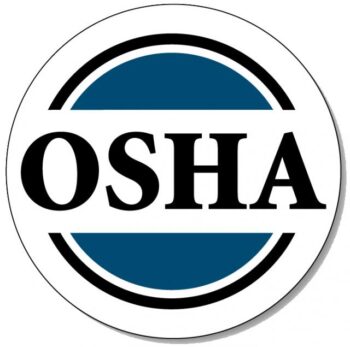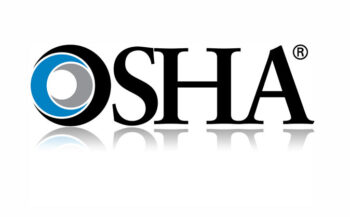The job of cleaning your medical office isn't for just any cleaning company. The cleaners you contract must have expertise in infection control for the safety of patients and staff. From the reception area and waiting area to treatment rooms, back offices and breakrooms, all surfaces must be regularly and hygenically cleaned. Biohazards, sharps and chemicals can pose a hazard … [Read more...] about 10 tips for hiring the right medical office cleaning company
OSHA
Keep your employees safe by complying with OSHA regulations
In a small medical office, the manager may be responsible for occupational safety, so make sure you know how to keep your workers safe and avoid OSHA violations. Here are some recommended approaches: OSHA Training Programs: OSHA (the federal Occupational Health and Safety Administration) provides a variety of training programs and resources specifically designed to help … [Read more...] about Keep your employees safe by complying with OSHA regulations
Where we are on vaccines and masks in the workplace
Vaccine roundup The Biden Administration, through Executive Orders and various agencies, has adopted four separate vaccine mandates for (1) employers with 100+ employees (the OSHA ETS), (2) federal contractors, (3) federal employees and onsite contractors, and (4) healthcare employers who receive Medicaid or Medicare reimbursements (the CMS mandate). Except for the CMS … [Read more...] about Where we are on vaccines and masks in the workplace
OSHA emergency vaccine mandate withdrawn and forced arbitration may end for workplace sexual harassment
By Mike O’Brien After a recent United States Supreme Court decision prohibited it, the Occupational Safety and Health Administration (OSHA) officially announced the withdrawal of its COVID-19 vaccination and testing Emergency Temporary Standard (ETS), effective Jan. 26, 2022. According to The Society for Human Resource Management (SHRM), “OSHA’s withdrawal of its COVID-19 … [Read more...] about OSHA emergency vaccine mandate withdrawn and forced arbitration may end for workplace sexual harassment
Supreme court blocks OSHA vaccine mandate, dissolves stay on CMS mandate for healthcare industry
By Mike O’Brien In a 6-3 decision, the U.S. Supreme Court has issued its opinion blocking OSHA’s vaccine mandate for employers with 100 or more employees. The majority ruled on Jan. 13 that OSHA had exceeded its authority when it issued the vaccine mandate, concluding that OSHA has authority only “to set workplace safety standards, not broad public health measures.” The court … [Read more...] about Supreme court blocks OSHA vaccine mandate, dissolves stay on CMS mandate for healthcare industry
Supreme Court to hear challenges to OSHA & CMS vaccination mandates this week
By Mike O'Brien On Dec. 17, 2021, the Sixth Circuit Court of Appeals dissolved the stay of OSHA’s vaccine mandate for employers with 100 or more employees in a split 2-1 decision. Wasting no time, OSHA published a compliance update to provide new deadlines. Covered employers have through Jan. 10, 2022, to adopt and publish a vaccination policy, to ascertain and record employee … [Read more...] about Supreme Court to hear challenges to OSHA & CMS vaccination mandates this week
OSHA updates guidance to track the latest CDC mask recommendations
By Mike O’Brien The U.S. Occupational Safety and Health Administration (OSHA) has updated its COVID workplace safety guidance entitled, Protecting Workers: Guidance on Mitigating and Preventing the Spread of COVID-19 in the Workplace. OSHA’s latest update on Aug. 13 “reflect[s] the July 27, 2021 Centers for Disease Control and Prevention (CDC) mask and testing recommendations … [Read more...] about OSHA updates guidance to track the latest CDC mask recommendations
Masks making a comeback and vaccine mandates are on
By Mike O'Brien Masks make a comeback On July 27, 2021, the CDC issued new guidance for people that have been fully vaccinated against COVID-19. Previously, the CDC had said that fully vaccinated individuals did not need to wear masks in public. However, largely in response to the spread of the Delta variant, the CDC now recommends wearing a mask indoors in public if you are … [Read more...] about Masks making a comeback and vaccine mandates are on
OSHA orders inspectors to use the hammer to enforce new COVID-19 protocols
On June 21, OSHA issued a new Emergency Temporary Standard (ETS) requiring health care providers to take extensive measures to protect frontline workers against risk of COVID-19 infection. Exactly one week later, the agency issued internal Compliance Directive 2021-02 (the Directive) telling OSHA inspectors how to enforce the new ETS. The 67 pages of instructions shed light on … [Read more...] about OSHA orders inspectors to use the hammer to enforce new COVID-19 protocols
The three laws of sharps safety
By Dan Scungio In Isaac Asimov’s writings about science, he created “the three laws,” a set of rules designed by humans that robots must follow in that fictional society. Robots cannot harm human beings, they must obey humans (unless it conflicts with the first law), and they must protect themselves from harm (unless that conflicts with the first two laws). With those in … [Read more...] about The three laws of sharps safety








